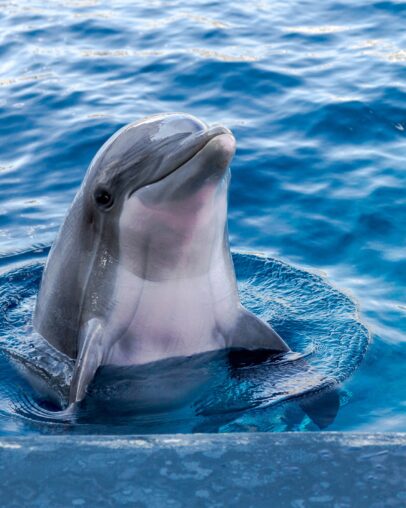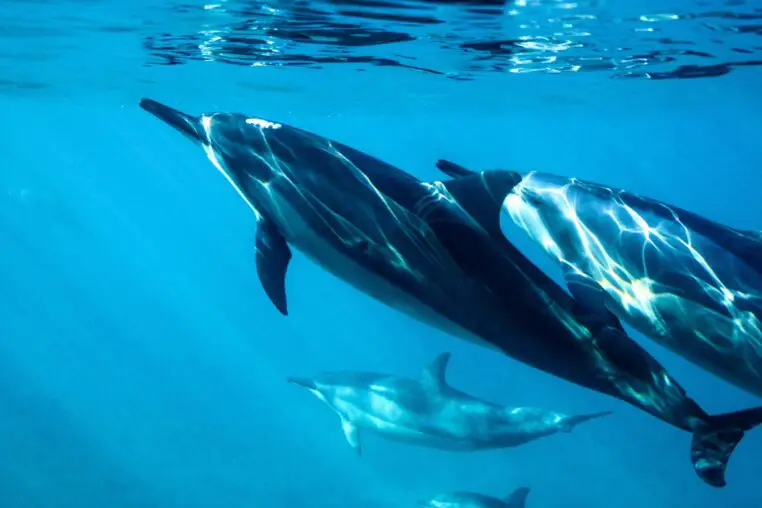
Picture yourself on a serene beach day, where the sun caresses your skin, the tang of salt fills the air, and the gentle waves serenade the shore. Suddenly, your eyes are captivated by a mesmerizing spectacle just off the coast.
Why Do Dolphins Swim Close to Shore
A troupe of dolphins, their sleek bodies exuding an air of playfulness, makes a stunning appearance. As they leap and frolic in the crystal waters, a question arises: why, indeed, do these enigmatic creatures swim so tantalizingly close to the shore?
Intriguingly, dolphins gravitate toward shallow waters for a multitude of reasons, including bountiful food sources, refuge from predators, and the allure of social interactions, often extending their affable nature to interactions with humans.
Furthermore, environmental elements like seasons, water temperatures, and tidal rhythms sway their proximity to the shore.
Delve into the depths of this captivating behavior, as we unravel the myriad mysteries of dolphins and their intimate dance with the shoreline.
Why Dolphins Swim Close to Shore: An Overview

Dolphins, charismatic beings of the deep, often tantalize beachgoers and sea enthusiasts by venturing close to the shore. But why? One reason lies in their social nature, drawing them near for a medley of feasting and social camaraderie.
Yet, there are instances where dolphins, due to old age, ailment, or injury, find themselves unable to navigate back to the depths, resulting in their poignant entrapment near the shoreline.
In such poignant scenarios, these creatures seek refuge in shallower waters, unable to return to the open sea, ultimately facing a fate of starvation or predation.
Dolphin’s Habitat and Environment
Before we delve deeper into their enigmatic shoreline sojourn, let’s explore the diverse habitats that dolphins call home. While oceans usually house these marine marvels, it might surprise you that there exist freshwater dolphin species inhabiting the riverine realms of South Asia and South America.
Astonishingly, dolphins have made a home in every Earthly ocean, spanning a size spectrum from the colossal orca, stretching 30 feet long, to the diminutive Hector’s dolphin, a mere 4.5 feet in length.
Location and geographical facets profoundly influence where dolphins reside and how they interact with their surroundings. Freshwater dolphins, for instance, adapt uniquely to life within riverine ecosystems.
Coastal dolphins, conversely, have a more intricate relationship with the shoreline, wherein elements such as food availability and sanctuary from predators sculpt their behaviors.
Dining Close to the Coast
The sustenance of dolphins primarily consists of fish and squid, and their dietary preferences sway with factors like their species, location, and prey availability. As such, you may spot dolphins edging closer to the shoreline in their quest for sustenance.
When on a shoreline hunt, dolphins deploy a repertoire of fishing techniques that showcases their adaptability and intelligence. Among these methods lies “strand feeding,” an audacious strategy wherein dolphins pursue fish right onto the shore, even risking their own temporary stranding. This perilous pursuit reflects their unwavering determination to secure their prey.
Another reason for their coastal forays pertains to the comparatively tranquil waves and currents near the shore. In these serene waters, dolphins can concentrate on their hunting endeavors, free from the tumultuous disturbances of deep-sea waves.
Evidently, dolphins are not lone rangers when it comes to prey capture; they orchestrate collaborative maneuvers to corral their quarry. Take, for instance, the coordinated efforts of bottlenose dolphins in shallower waters, joining forces to herd fish toward the shoreline, where a bountiful harvest awaits.
Social Symphony by the Shore
Dolphins, renowned for their gregarious nature, frequently gravitate toward the shoreline to engage in an array of group activities. When observing dolphins close to the shore, you’ll discern their propensity to travel in pods—intimate groups that nurture playful interactions, affectionate exchanges, and protective instincts.
The pod dynamic becomes a shield, safeguarding members, including the young, from potential threats. While dolphins typically exude amiability, their pod allegiance can manifest as staunch protectiveness.
Approaching the shore also offers the dolphins a platform for play and socialization. As their inherent curiosity beckons, these gentle beings often venture close to people and boats, revealing their exuberant side through somersaults, leaps, and spins.
Moreover, their social synergy extends to cooperative hunting endeavors. In these synchronized exploits, they encircle schools of fish, orchestrating their migration toward the shallows, where capturing their prey becomes a seamless venture.
Harmonizing with Other Species Near Shore
When dolphins swim along the shoreline, their interactions extend beyond their pod. You’ll witness them harmonizing with various species, including whales, orcas, pilot whales, boats, and even humans.
Their naturally affable disposition prompts them to forge bonds and engage in playful interactions with fellow inhabitants of the shoreline realm.
A particularly intriguing facet is the dolphins’ proclivity to establish unique cross-species alliances, exemplified in the Bahamas, where they coexist harmoniously, foraging and frolicking alongside other dolphin species. This intricate social network fortifies their bonds and shields them from potential hazards, such as predators or environmental exigencies.
Notably, boats and humans inhabiting the shoreline territory furnish distinctive avenues for interaction. Dolphins find boats intriguing, often riding the waves generated by their locomotion. In turn, humans are privy to the acrobatic displays of these agile swimmers.
Whales, especially their larger counterparts like orcas and pilot whales, share the same marine milieu with dolphins. While orcas, or killer whales, are known to prey on smaller marine mammals, they seldom pose a direct threat to dolphins near the shore. Instead, a harmonious coexistence prevails as they navigate their shared ecosystem, foraging and exploring side by side.
Given their convivial nature, dolphins are even known to communicate with other species, as exemplified in Scotland’s Firth of Clyde, where an observant dolphin, Kylie, engaged in interactions with neighboring harbor porpoises.
Anatomy’s Influence on Shoreline Activities
Dolphins have evolved over ten million years, crafting an anatomy tailor-made for marine life. Their body size and contours facilitate agile navigation in both deep and shallow waters. Their streamlined physique is an embodiment of swimming efficiency, making them equally at home near the shore.
Notably, dolphins, akin to all mammals, require oxygen. To facilitate this need, they possess a blowhole atop their heads, permitting respiration even during close-to-shore swims. The sight of dolphins surfacing for breath is not only routine but an indispensable aspect of their biological composition.
Their anatomy also endows them with remarkable swimming prowess. Robust flippers empower them to breach the water’s surface or plunge into its abyss when hunting for sustenance. This unique ability to dive serves them well, whether navigating the depths of the ocean or frolicking near the shore.
Their tails, or flukes, function as powerful propellers, propelling them through the water with impressive speed and agility. This aquatic athleticism enables dolphins to confidently traverse both deep and shallow waters, accounting for their frequent sightings near the shore.
Sounds and Communication in Shoreline Realms

Dolphins engage in a symphony of vocalizations, including whistles and squeaks, to communicate within their pods. Each dolphin possesses a distinctive whistle, akin to a name, which aids in identifying fellow pod members.
When dolphins venture close to the shore, you may observe an uptick in their vocalizations, adapting to the heightened ambient noise levels in these areas.
Echolocation represents another pivotal facet of dolphin communication. Dolphins emit clicks and discern returning echoes, a built-in sonar system that facilitates navigation in their watery domain.
This echolocation becomes especially critical in shallow waters near shorelines, where potential obstacles like rocks and seaweed demand precise navigation.
However, the auditory landscape dolphins rely upon can be disrupted by human activities and ambient noise. Noise pollution, stemming from boat traffic and underwater construction near the coast, can impede their communication and echolocation capabilities.
In response, dolphins may need to modify their vocalizations or employ alternative methods for effective navigation and communication in these close-to-shore environments.
Health and Safety Considerations
Another compelling reason for dolphins to approach the shore revolves around their physical condition. Some dolphins may be aged, ailing, injured, or disoriented, which curtails their swimming abilities.
As these dolphins contend with advancing years or suffer from health afflictions like diseases and parasites, their capacity to navigate the open waters diminishes. In such circumstances, they gravitate toward shallow waters, seeking respite where they can rest more comfortably.
It’s crucial to exercise caution when encountering dolphins in these conditions. Interacting with stranded dolphins can pose risks both to humans and the dolphins themselves. Stranded dolphins are wild animals, and getting too close may inadvertently harm them.
Maintaining a safe distance and promptly reporting stranded animals to local authorities or wildlife organizations remains the prudent course of action. Feeding or harassing wild dolphins is not only inadvisable but illegal in many regions, emphasizing the necessity of appreciating these marine marvels from a respectful distance.
Perils and Conservation Endeavors
Despite their adaptability to diverse aquatic environments, dolphins grapple with a host of threats in the wild. Climate change stands as a prominent challenge, affecting their migratory patterns, food availability, and reproductive cycles.
In their close-to-shore encounters with humans, dolphins may encounter additional perils. As they navigate these waters, they face the inadvertent menace of boat propellers, which can inflict grievous injuries.
Furthermore, the allure of human presence tempts dolphins into consuming human food items such as beer, pretzels, and candy, leading to potential health complications.
Accidental entanglement emerges as a grave threat to dolphins swimming near the shore. These marine creatures may become ensnared in fishing nets, particularly the fine-mesh gill nets, which they struggle to detect underwater. Bycatch scenarios resulting from such encounters often culminate in injury or fatality for these dolphins.
Nonetheless, valiant conservation efforts are underway to safeguard dolphins and their habitats. One fundamental step individuals can take is to observe dolphins from a safe distance, abstaining from feeding or approaching them closely with boats.
Esteemed organizations like the World Wildlife Fund tirelessly champion improved fishing practices, advocate for the sustainable utilization of marine resources, and elevate public awareness concerning the importance of preserving these remarkable creatures.
By embracing responsible behavior in the vicinity of dolphins and lending support to conservation initiatives, we collectively contribute to nurturing a safer environment where these extraordinary beings can flourish, even amidst the dynamic shifts of our planet’s climate.
As we bask in the wonder of dolphins swimming close to the shore, let us also reflect upon the responsibility we bear in safeguarding their habitat and ensuring the continuity of this captivating marine symphony for generations to come.









